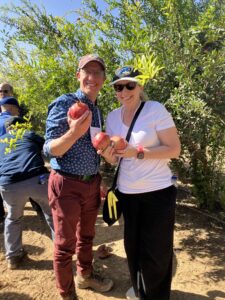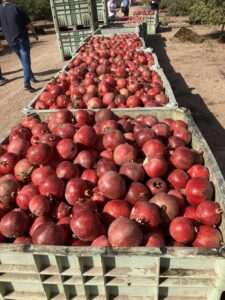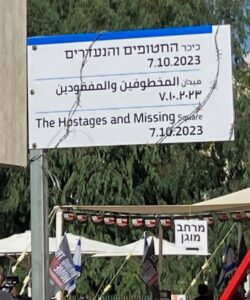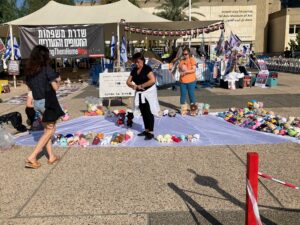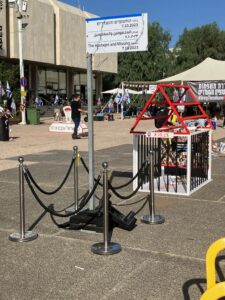Rabbinic Solidarity Mission to Israel – November 5 – 7, 2023
Rabbi Abe’s Reflections on the Rabbinic Solidarity Mission to Israel
Over November 5-7, 2023, I had the privilege of participating in a Rabbinic Solidarity Mission to Israel, sponsored by the Jewish Federations of Greater Philadelphia and Northern New Jersey. Although the mission was financially supported by Federation, the money was not drawn from the Emergency Relief Fund, which entirely goes toward relief projects in Israel – some of which we saw up close while on the ground in Israel. If you have not yet contributed to the Emergency Relief Fund, you can join the campaign by clicking here.
What you read below is a snapshot in time: my reflections at the end of each day, written in the moment and shaped by my immediate emotions and responses. There are many more pictures than I could include with the writing, and you can click here to see the full set of pictures. If it seems in some of the pictures like we were having fun, sometimes we were. Part of the strange disorientation of this time in Israel, and I believe for many American Jews as well, is the ways in which tragedy and gratitude, loss and joy, fear and hope intertwine within each person. October 7 revealed the ugliness and brutality that human beings are capable of inflicting on one another and at the very same time brought to the surface the lengths that some people will go to support, comfort and nurture one another. אלו ואלו, all of these things are true.
I will have more to say as I digest and process the mission; these reflections stand as a testament to how I experienced, in the moment, two and a half days in our Jewish homeland during a time of war and grief.
Rabbi Abe Friedman
Philadelphia, November 9, 2023
“Hope Dies Last” (Day One, November 5)
This evening we had dinner with Inbar Goldstein and Yamit Ashkenazi, women who grew up on Kibbutz Kfar Aza and who have family members currently held hostage in Gaza: Yamit’s sister, Doron Steinbrecher, and Inbar’s sister-in-law, Chen, and three of her children, Agam, Gal, and Tal. Inbar’s brother, Nadav, and his oldest daughter, Yam, were murdered in the Oct. 7 attacks.

Yamit described the area of southern Israel around Kfar Aza, where she grew up and lived as an adult with her husband and two children, as “95% heaven.” In 1999 I lived on Kibbutz Sa’ad, just up the road from Kfar Aza, and I remembered the area exactly as she described it: green and well-kept, kibbutzim and small towns that were real communities, not just places to live. Yamit’s family has had no contact with Doron since she was kidnapped on Oct. 7; they have appealed to the International Red Cross because Doron needs daily medication, and have heard nothing back from the Red Cross either.
Inbar shared the many different shades of loss: the twin funerals for her brother and niece, the days of uncertainty before the Israeli government confirmed that Chen and her three surviving children were captive in Gaza, the daily anxiety of not knowing if Chen and her kids are healthy or if they are even all together. She also spoke of counting blessings: Her parents, with other friends from Kfar Aza, were on vacation in Europe at the time and remained safe from Hamas’ assault. In closing, Inbar repeated one of her brother Nadav’s favorite aphorisms: “Hope Dies Last.”
Just before dinner, sirens alerted us to a missile launch from Gaza and we scooted quickly into the hotel’s central stairwell to take shelter. A few minutes later, the “all clear” sounded without incident.
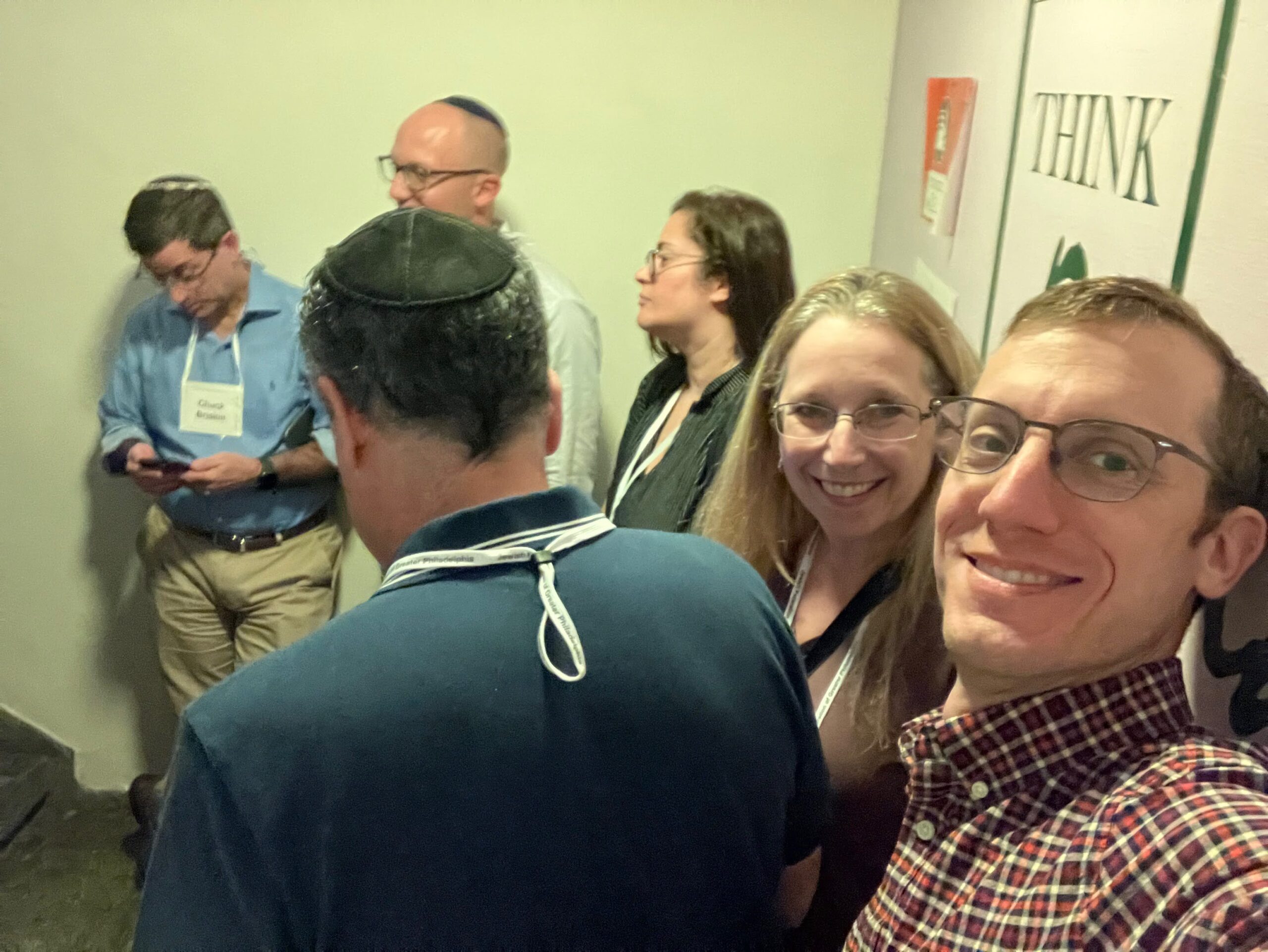
We ended the night with a walk down Sderot Dizengoff to Dizengoff Square, the central gathering point in Tel Aviv. The benches along Dizengoff are lined with human-sized teddy bears, bound and bloodied, symbolizing the 37 children still held hostage in Gaza. Families and friends have surrounded the fountain at the center of Dizengoff Square with shrines dedicated to child hostages and memorials of youth murdered by Hamas.
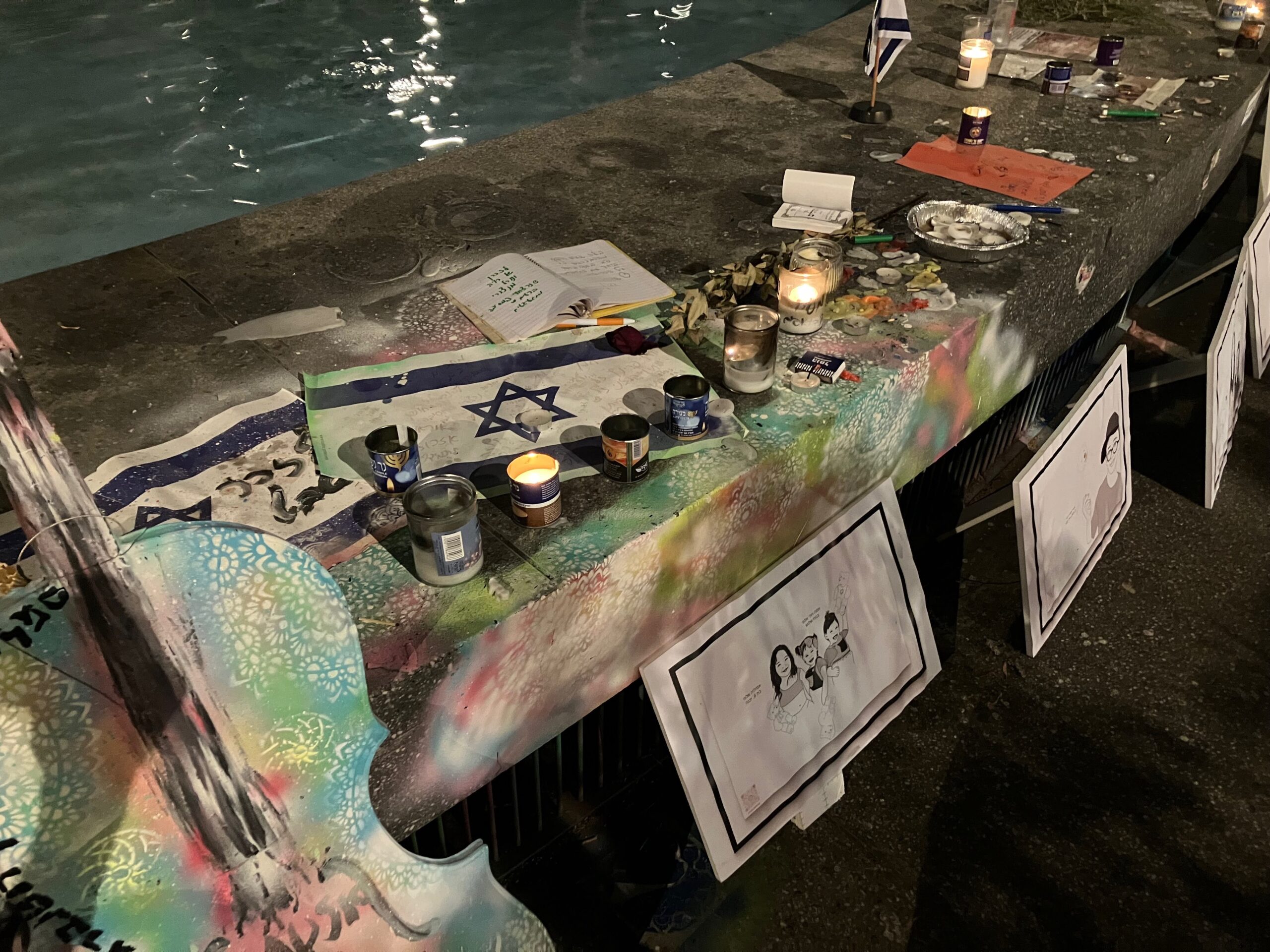
I am left with the profound sense that the families of the hostages in particular – but to some extent all of Israel and, I think, many in our own Jewish community – are living in a state of suspended animation. While time keeps moving and each morning brings a new day, life won’t truly move forward until the hostages are home. Inbar and Yamit directly addressed the calls in America and throughout the world for a “humanitarian ceasefire,” insisting that “humanitarian” must apply to all sides equally – a true humanitarian ceasefire must also include the immediate and unconditional return of all hostages.
As we said good night, I shared with Inbar how many of you regularly express your concern for her sister-in-law, niece and nephews, and all who remain in captivity simply because they are Jewish. The small actions you take each day – hanging posters, raising awareness among your friends and co-workers, especially beyond the Jewish community, even just knowing that you are thinking of their families brings immense comfort to everyone here.
I am ending the night immensely grateful for the opportunity to serve a community that cares so deeply for the entire Jewish people, and to be able to be here in Israel on behalf of our congregation.
“Never Alone” (Day Two, November 6)
Today we focused on the way October 7 and its aftermath has reshaped Israeli civil society. Over and over we heard how small circumstances – bad luck, good luck, dumb luck – created vastly different outcomes. Sderot, the closest city to Gaza, suffered immense casualties; Netivot, Philadelphia’s partnership city, was spared simply because a Hamas unit made a left turn instead of a right turn, bringing their horrors to a different community instead.
Sdot Negev, our other partnership region, was more deeply impacted. In addition to the loss of life and kidnappings, many towns in Sdot Negev were evacuated by the IDF at the start of the war. There are now over 140,000 internally-displaced Israelis, including residents of the north who have been evacuated to keep them safe from Hezbollah’s rockets, taking up residence in hotels across the center of the country (more on this later).
While most kibbutzim have managed to reunite and settle into the same hotel, preserving their community and beginning to heal even during their displacement, the towns of Sdot Negev are less centrally organized and in most cases the residents have scattered to different parts of the country. Hearing these stories from Tali Lidar, Philadelphia Federation’s Director of Israel and Global Operations, reminded me of the way New Orleans residents struggled to stay connected after Hurricane Katrina and the challenges they faced rebuilding after a prolonged separation.
We spent part of the morning in a pomegranate orchard in Bat Hadar, a moshav (farming community) south of Ashkelon. The pomegranate harvest should have started on October 8 – the second day of the war. Ordinarily the farmers employ eight long-term agricultural workers from Thailand and hire another twenty West Bank Palestinians seasonally for the harvest; this year they were unable to hire additional seasonal help and the Thai workers either evacuated home or took agricultural jobs on farms located in the center, farther from Hamas rockets, leaving this farm without any way to harvest their 25 acres – 500 tons of fruit. Beyond the potential loss of this year’s crop, if the fruit begins to rot on the tree it can actually damage the entire tree. Volunteers from across Israel have stepped in to help with the harvest, so far picking about 75% of the fruit and saving the farmers from a dire situation. Even with this help, the delayed harvest means these pomegranates are not fit for food or export, and instead have been sold to companies that will use them for juice and cosmetic oils.
BZBI Executive Director Lynne Balaban and Rabbi Abe help pick pomegranates in Bat Hadar. Each crate holds one ton of fruit.
Next we traveled to Ofakim, a “City of Heroes” where fifty residents armed only with personal weapons fought back against Hamas and saved many of their neighbors. Fifteen years ago, as Sderot and other communities faced relentless rocket attacks from Gaza, the Israel Trauma Coalition set up “resilience centers” to help residents prepare for future emergencies, develop emotional resources for personal and community resilience in the face of uncertainty and provide emotional first aid in the aftermath of attacks and other traumas. More recently, with support from our Federation, ITC established a regional resilience center to serve communities in the next circle out from Gaza, which includes Ofakim.
At the resilience center, we spoke with Tzipporah, a crisis social worker and fellow resident of Ofakim. Beyond describing the details of her work, she shared the impact of support from communities like ours: “I can’t promise my children that tomorrow there won’t be terrorists in the streets of Ofakim again,” she said. “I can’t promise my children that there won’t be missiles. I can promise them that tomorrow, and forever, the Jewish people will always be with them and they will never be alone.”
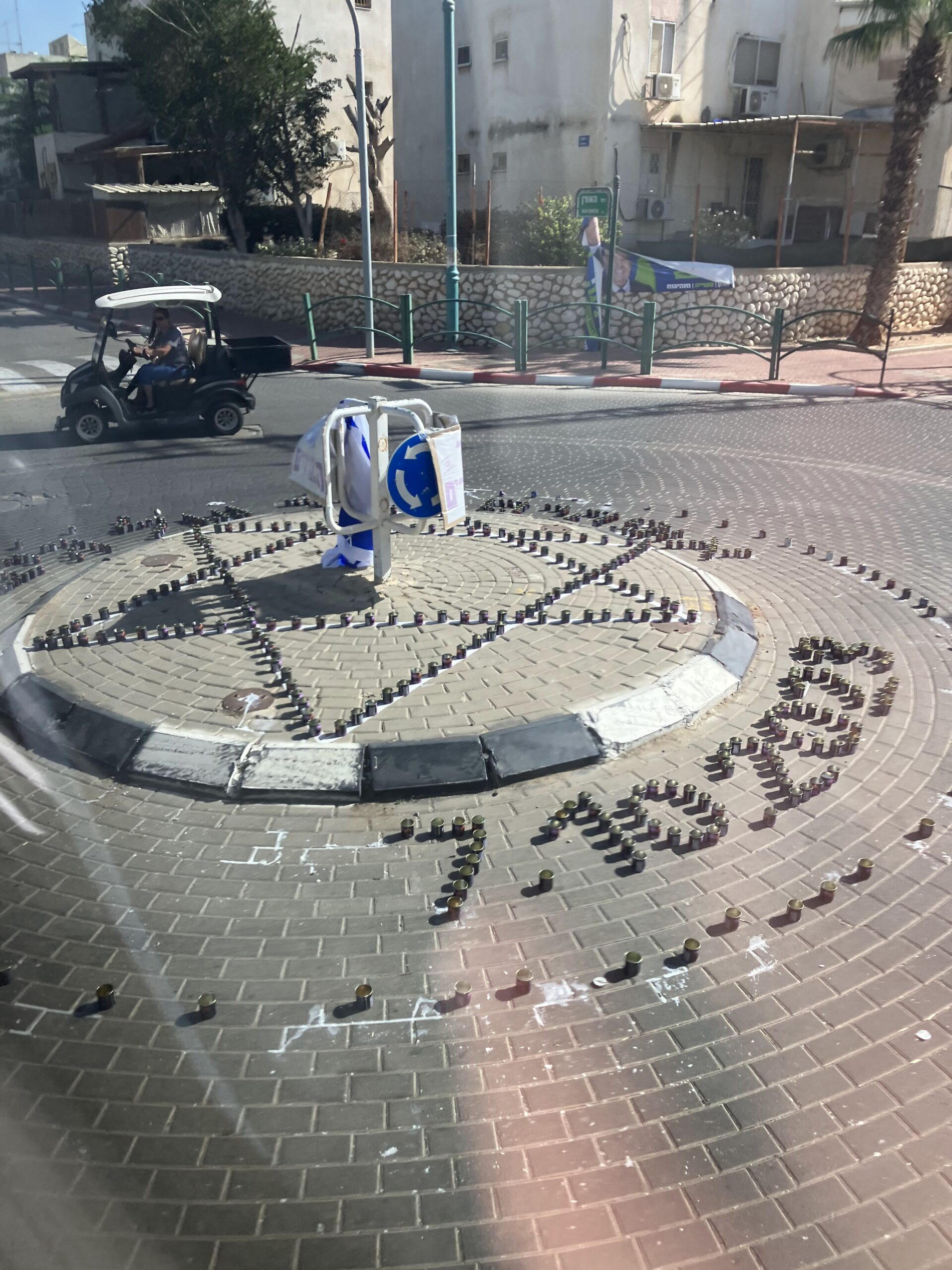
Memorial in Kikar Giborim (Heroes’ Square), Ofakim
From there we visited an IDF base and were hosted by the human intelligence unit that is responsible for debriefing captured Palestinians and gleaning information that can save lives as the IDF moves deeper into Gaza. While I can’t repeat any details of what we heard (we had to leave our phones on the bus and could not take notes), I can share how impressed I was with the commitment shown by everyone we met – a commitment to relentless efforts to secure the return of hostages and prevent anything like October 7 from happening again matched by a commitment to human dignity, a sense that part of their mandate in gathering this intelligence was also to mitigate as much Palestinian civilian suffering as possible.
Returning to Tel Aviv, we went to the beachfront Crowne Plaza hotel where hundreds of families evacuated from Sderot have taken up residence. The reality is not as lovely as “beachfront hotel” suggests: we met a mother of four children who told us, with substantial understatement, that their hotel room is nice but not nearly large enough for a family of six. The hotel turned over several ballrooms and, with the help of donors and volunteers from Dror Yisrael, the alumni arm of the Habonim Dror youth movement, they converted these rooms to a mix of school and rec room – somewhere for the kids to go, supervised by teen and college-aged volunteers, giving the parents a break and providing some structure and order to their days.
Once it became clear that the war would last for a significant time, Dror Yisrael began opening quasi-schools in most of the hotels, meeting for 3 hours Monday through Thursday. In Haifa and Eilat, they have now set up full K-12 schools to serve the displaced families; in Tel Aviv, the kids are likely to end up enrolling in local public schools and will probably finish the school year still displaced. Dror Yisrael is providing the human touch and the long-term ongoing support that the government does not offer – working to ensure that displaced communities can maintain a sense of belonging and purpose despite the burdens they face.
The organizations we visited today are directly supported by the Jewish Federation’s Emergency Relief Fund. If you have not yet contributed, you can join the campaign by clicking here.
We finished with an incredibly moving presentation by Lucy Aharish, an Arab-Israeli Muslim journalist whose passionate appeal for democracies worldwide to support Israel brought her to CNN and helped spread her message even further. She told us about the terrorist attack on her family when she was just five years old (a story she also tells in the second video linked above). Within the complexities of the Israeli-Palestinian conflict lie even deeper conflicts for Israeli Arabs: a struggle within themselves between conflicting identities of Israeli and Palestinian. Lucy shared the pushback she often received from other Arabs when she would insist on defining herself as “Israeli,” and shared that after October 7 she has heard more of her friends sharing, “If this is what it means to be Palestinian, I don’t want it.”
Lucy also shared her concern that on “the day after the war,” whenever that comes, Israel will not be able to go back to the way things have been. Israel needs new leadership that will commit itself to a resolution to the conflict – leaders who will move past the ambivalence that has characterized Israeli policy and define what they believe Israel’s borders should be and commit themselves fully. She believes that Israeli’s slide toward extremism and away from democracy weakened Israel’s government – although not its people – and left the country vulnerable on October 7. A commitment to democracy, and a willingness to to make unpopular but necessary decisions, must be the way forward.
“We will lose our best men and women defending our country,” she told us in conclusion, “But we are not going anywhere. We are fighting so our children can rebuild.”
As we travel by bus, the entrance to every town in the south still has a military checkpoint. Every intersection is covered with signs devoted to Israeli unity, commitment to victory over Hamas, and commemoration of October 7 – too many to photograph them all. The one I am taking with me from today: “עם נצחי לא מפחד מדרך ארוכה,” “An eternal people need not fear a long road.”
We are also part of that eternal people, the Jewish people, and we will never be alone.
“Accountable for One Another” (Day Three, November 7)
Today was the hardest day and the most hopeful day, the day when we confronted the worst of Hamas’ crimes and saw the greatness Israeli society is capable of achieving.
November 7 marks one month since 1,400 Israelis and foreign nationals lost their lives, one month of captivity for the hostages, one month that Israel has been at war. The signs of war in Tel Aviv are subtle: streets are emptier than usual, but not so empty that the change is immediately noticeable. Businesses have started reopening, and yet the restaurant where we ate dinner told us this was the first night they were open to customers since October 7. And as we traveled south, to Philadelphia’s partner city of Netivot and partnership region of Sdot Negev, the war became inescapable: we could see smoke rising from Gaza City, we heard nearby Israeli artillery firing into the Gaza Strip, drove through military checkpoints at vital intersections, and as the sun set began to see Iron Dome interceptors launching to take down Hamas rockets.
We began our morning at Kikar HaḤatufim (Hostages’ Square). Located directly in front of the Tel Aviv Museum of Art and next door to the Central Library and HaBima Theater, Kikar HaḤatufim has become famous for its “Shabbat Table,” set with 240 empty chairs representing the missing hostages, which has been copied around the world including in Philadelphia.
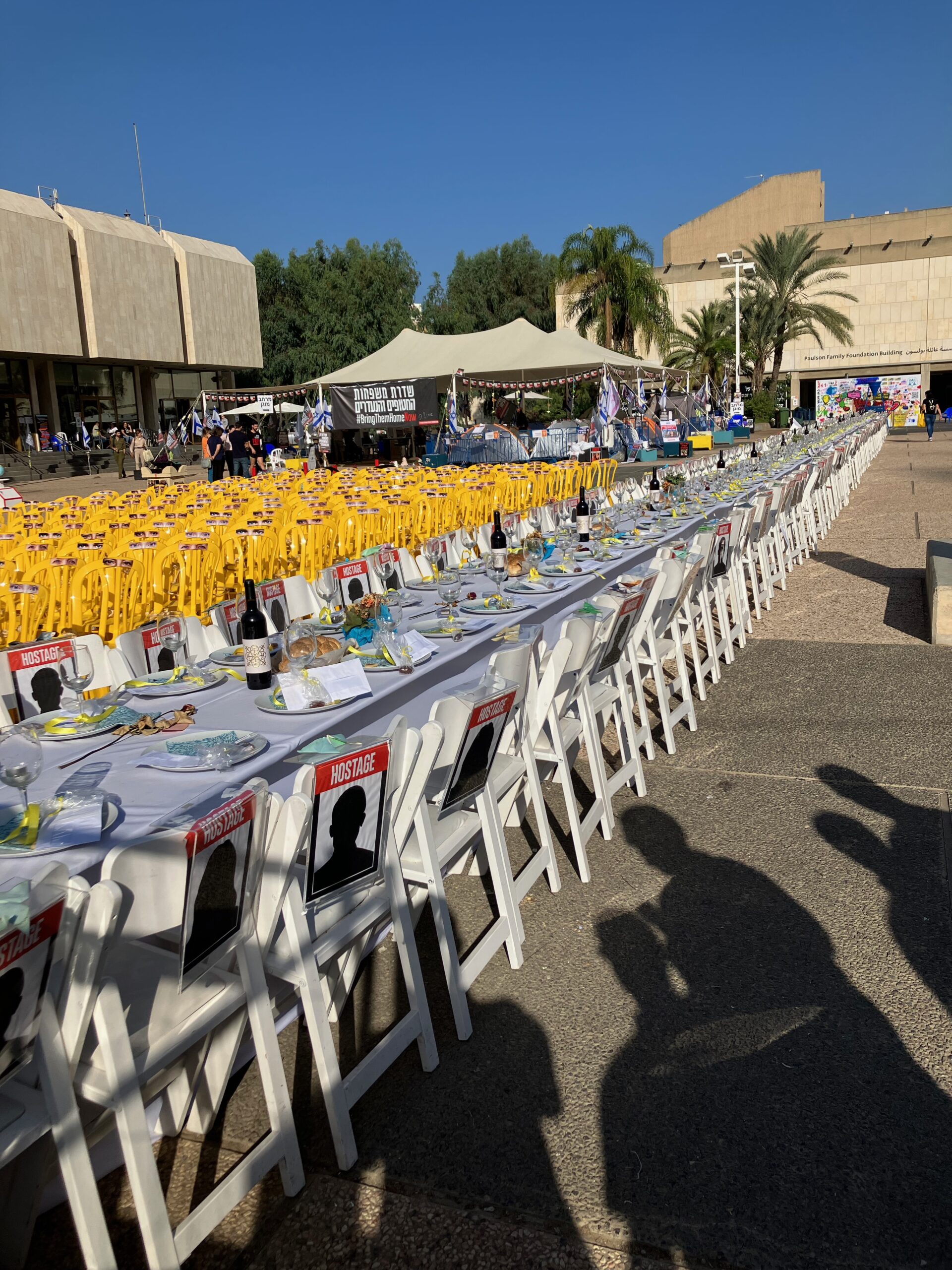
Artists and craftspeople have added more pieces to the open-air exhibition. A group of “National Knitters” knitted small teddy bears for each of the hostages. Another piece mimics the municipal signs throughout Tel Aviv, reading “Hostages’ Square” in Hebrew, Arabic, and English; it looks almost official until you notice that the sign is also draped in barbed wire.
There is another dimension to this site. Yes, it is a heavily-trafficked public space with a deep connection to the arts; it is also directly across from the Kiryah, the central IDF headquarters. No one working in IDF command can go in or out of their offices without coming face to face with the hostages’ families. Many families have moved into a tent city on the square, living and sleeping there too so that not even a minute will pass without the IDF command facing the reality of the hostages.
Netivot, Philadelphia’s partnership city, is another place whose story reveals Israel’s creative spirit and shows the heroism of ordinary citizens. Over the years since Hamas took control of Gaza, the nearby kibbutzim (collectives) and moshavim (farming communities) set up civil defense units, groups of local volunteers who trained and prepared to defend their towns in case of attack. Netivot, however, was the only major city (pop. 47,800) to develop a civil defense force – and, at the time, Netivot’s mayor, Yehiel Zohar, was mocked as an alarmist.
Yehiel turns out to have been tragically prescient: in the City Hall command center, we watched security footage from October 7 that showed civil defense units – in private cars and armed with personal handguns – blocking the entrances to the city by 7:30 AM, just one hour after attacks began. As the recording sped toward 8:30, we saw a stolen car full of terrorists drive past the first blockade, firing from the car. They approached a second entrance to the city, also blocked, and sped past, but here the guardians had advance warning and one car and a motorcycle pursued the terrorists down the road – ultimately killing all of the attackers in that car.
As dramatic as the footage was, what we heard next gave the story new significance. As Israel has reconstructed more of Hamas’ attack plans, they learned that the terrorists were instructed not to fight back or engage any defenders: if they found a place well guarded, they were told to just move on and look for a softer target, a place where they could inflict greater casualties. By not only preventing the terrorists from gaining access to Netivot but also intercepting them along the road and stopping their progress for good, Netivot’s civil defense force undoubtedly saved many more lives in other areas.
The civil defense forces were only the beginning of Netivot’s marvels. Yehiel, the mayor, took us into a special call center at City Hall for their 106 system – a single phone number residents can call to access all city services as well as referrals to private nonprofit organizations who offer support. The 106 system is entirely staffed by volunteers, some city employees and many more who work elsewhere in Netivot and take time to answer phones, write up referral tickets, and follow up on the status of previous cases. Most remarkable of all, Netivot has a comprehensive information system that helps them notice when people need help but aren’t asking. One volunteer shared an example of the impact these systems have had on Netivot: a woman called 106, which also operates a food-and-supply delivery program similar to JRA, and requested infant formula and diapers in a size that would fit an elementary-school child. In the warehouse, they noticed the mismatch and sent a message to a social worker, who visited the family and learned that in addition to their newborn, they had an older child experiencing psychological regression in the wake of October 7 and had started wetting the bed at night. Because the social worker was now with the family, they were able to begin providing comprehensive emotional trauma care.

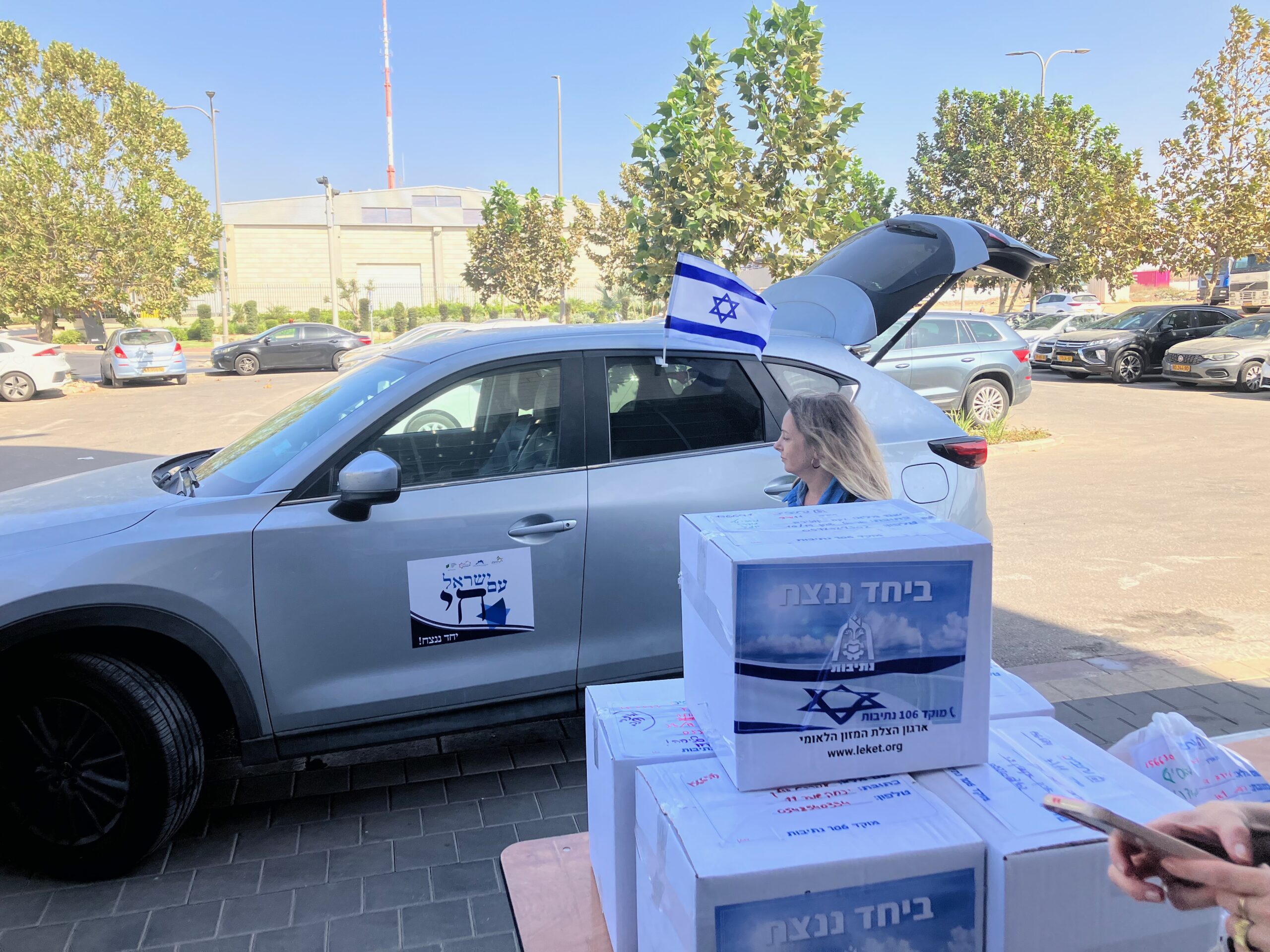
Tali Lidar, Philadelphia Federation’s Director of Israel and Global Operations, holds one of the tags that the 106 system uses to mark boxes for volunteer delivery. Outside, a volunteer picks up boxes from the distribution center.
Netivot is surrounded by the Sdot Negev Regional Council, also a partnership region for our Federation. Regional Councils are similar to a county government: they are a way to administer and provide government services to areas with a lighter population and no municipal government of their own. Sdot Negev covers fourteen towns and two kibbutzim, Alumim and Sa’ad, and is one of three Regional Councils that directly border the Gaza Strip.
We had time for a brief meeting with Rafi Babian, Sdot Negev’s head of security, who shared his October 7 story. I found it strange, however, that when our guide began moving us back toward the bus for our next stop, Rafi climbed on the bus and insisted that he had to take us somewhere else before we could leave.
Nothing could have prepared me for what lay behind a hill just ten minutes down the road: an open dirt field the size of a stadium parking lot, packed with hundreds of cars burned down to their frames – no glass, no upholstery, no tires, half-melted engine blocks.

These cars were recovered from the Nova Festival and along the roads throughout the region, and this is just one of three sites this size. We arrived in time to see departing volunteers from Zaka, an organization devoted to identifying people murdered in terrorist attacks and ensuring that even the smallest pieces of human remains are returned to families for proper burial. For weeks they have been carefully taking these cars apart, finding fragments of bone and sending them for DNA testing to identify the deceased.
As we stood among the cars Rafi’s voice dropped low. “In every one of these cars,” he told us, “Best case scenario there were only two people in the car, but a lot of times it was four or five. Times every car here. Times the other sites like this.” I found myself staring at the bare metal seat frames: someone sat there. Rafi recalled his two trips to Poland, of seeing the piles of shoes and luggage at Auschwitz, and for once the analogy to the Shoah didn’t seem exaggerated or tasteless. I understood his point: only when we see familiar everyday objects distorted by atrocity can we start to wrap our heads around the magnitude of the horror.

And even as we stood there, we could hear and feel Israeli artillery firing from just beyond the next ridge.
In Ashkelon we met Dr. Hezi Levy, the CEO of Barzilai Medical Center, who was also Israel’s equivalent of Dr. Fauci during the COVID pandemic. He walked us through the evolution of Barzilai, one of Israel’s main hospitals. The first hospital building was finished in 1961, at a time when no one imagined the need to fortify a hospital or create shelters for patients – but Ashkelon is just 10 miles from the border with Gaza and people in Ashkelon have at most 20 seconds to take shelter before a potential rocket strike.
As you can imagine, even reasonably mobile patients would have trouble getting to a shelter in that time, to say nothing of intensive care, neonatal, people in the midst of surgery – and on and on.
In response, Barzilai, like many other Israeli hospitals, built an updated facility that includes 285 beds, ten operating rooms, and an emergency department – all two stories underground, where the hospital can operate at full capacity in the midst of Hamas bombardment. On October 7, all of the patients were moved to safety in five hours, protecting patients and staff alike when three rockets landed on the hospital later that day.
At Barzilai we also spoke with Dr. Dov Frankel, an ER doctor from Baltimore who came to Barzilai for a two-week deployment with the Emergency Volunteers Project. EVP is a program that facilitates bringing American firefighters, nurses and doctors to Israel in times of war and crisis. By operating in successive waves of two-week deployments, EVP can quickly provide ongoing support over a fairly long time period. The firefighters, most of whom are not Jewish, go in pairs to join Israeli fire companies whose regular members have been called up for military service; the doctors and nurses might also be covering for doctors on active duty or might be called in because there is higher demand for their specialty in this moment – like experienced emergency doctors and trauma surgeons. And Dov pointed out that the impact is bigger than the volunteers who go to Israel: he needed other doctors in Baltimore to take extra shifts for the two weeks that he is away, and he shared his deep gratitude that every one of his partners stepped forward to make it possible for him to get the time off.
The first two waves of EVP firefighters were underwritten by the Jewish Federation of Greater Philadelphia’s Emergency Relief Fund. If you have not yet contributed, you can join the campaign by clicking here.
My plane is over Hamburg right now as I try to make sense of these two and a half days. Thirty-two days have passed since our world changed forever, thirty-two days that our hostages have been imprisoned in Gaza, and tomorrow will be 85 years since Kristallnacht. Each year I remember the first time I had lunch with Dr. Ernie Kahn ז״ל and he shared his life story with me, including a hastily prepared American bar mitzvah in December, 1938, because after Kristallnacht his parents quickly decided they could not remain in Germany any longer.
Kristallnacht is not the same as October 7; Hamas are not Nazis and Jews today – in Israel and throughout the world – live a different reality than European Jews of the 1930s. Safer in some ways and perhaps less safe in others. But in at least one way the comparison can help us understand what this moment asks of us as Jews and as human beings. If the message of Kristallnacht – tragically unheeded by so many – was get out, the message that Israelis and so many Diaspora Jews have taken from October 7 is stand together, stand strong. Israelis have no other home, no other option, and I think many of us in the Diaspora have felt an equally strong pull from the well-known rabbinic aphorism, “כל ישראל ערבים זה לזה,” “All Jews are accountable for one another.”

Art installation at Kikar Ḥatufim: “All Jews are accountable for one another.”
The most surreal moments of the trip came when we would be introduced to a new Israeli and they would immediately ask, “How are you? How are you holding up? How is your community?”
That, ultimately, is one of the core messages of Judaism: we look out for one another, no matter how rough our circumstances may be. We were barely a dozen people who offered essentially no material support beyond picking a half-ton of pomegranates (out of 500 tons that needed to be picked) and still people told us how much it meant to them that we came – how much it meant to them knowing that our community keeps Israel in our hearts.
And there is more to do. We are accountable for one another, and everyone we spoke to said that they need one specific thing from American Jews: keep talking about the hostages. Hang signs. Call Congress, call our senators, write to the White House. Keep the hostages front and center until, God willing, they are brought back to their families.
All Jews are accountable for one another.




